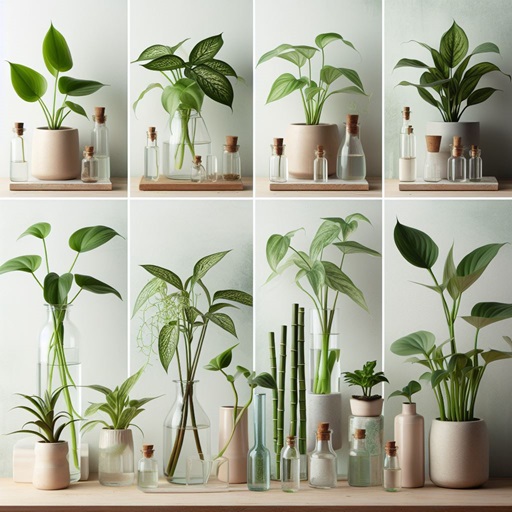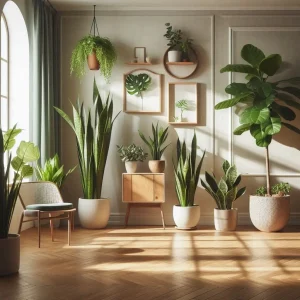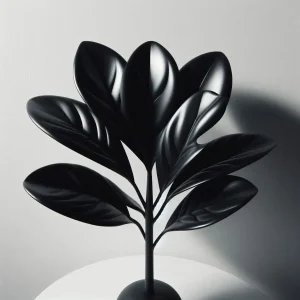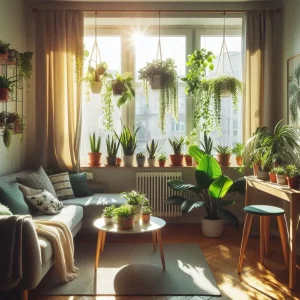If you want to cultivate various plants that can thrive in water and simultaneously enjoy the sight of white roots, we recommend joining us to become familiar with different types and their cultivation methods in water.
List Of houseplants that grow in water
Page Contents
ToggleBasil and Its Varieties
All herbs, including plants that grow in water, can be cultivated either from seeds or by propagating from grown herbs. Don’t forget that ample sunlight is necessary for growing various herbs, so it’s recommended to place your plant near a sunny window.
| Plant Name | Growth Medium | Propagation Method | Sunlight Requirement | Placement Recommendation |
| Basil and Its Varieties | Water or Soil | Seeds or Propagation from Grown | Ample sunlight required | Near a sunny window |
For more information you can visit holy basil care.
Vegetable Additions
If you have recently cleaned celery, lettuce, Swiss chard, green onions, etc., and notice they have trimmings and leftovers, keep about 5 to 8 centimeters of the base of these vegetables. Suspend them in water using toothpicks, making sure they don’t touch the bottom. After a while, you’ll see the plant starting to develop roots. However, don’t expect the plant to provide the same quality as the original. For faster growth, you can use specific fertilizers for vegetables.
| Vegetable Name | Growth Medium | Propagation Method | Sunlight Requirement | Additional Notes |
| Celery | Water | Base Trim, suspend with toothpicks | Adequate sunlight | Roots develop over time. Quality may differ from the original. Use vegetable fertilizers. |
| Lettuce | Water | Base Trim, suspend with toothpicks | Adequate sunlight | Roots develop over time. Quality may differ from the original. Use vegetable fertilizers. |
| Swiss Chard | Water | Base Trim, suspend with toothpicks | Adequate sunlight | Roots develop over time. Quality may differ from the original. Use vegetable fertilizers. |
| Green Onions | Water | Base Trim, suspend with toothpicks | Adequate sunlight | Roots develop over time. Quality may differ from the original. Use vegetable fertilizers. |
Before introducing another one of the houseplants that grow in water, we invite you to also check out the best plants for baby nursery.
Pothos Plant
Pothos is one of the plants that grow in water, known for its beautiful coloring, unique patterns on leaves, and trailing stems. The distinctive characteristics of the pothos leaf, which we are all familiar with, make it a popular plant for homes and gardens.
Taking care of this colorful plant in a hanging pot or alongside green leafy plants adds a vibrant spectrum of colors(color range) to the space, enhancing its beauty. Despite its decorative purposes, you can cultivate this beautiful plant inside water without the need for soil.
If you have pruned or broken stems of the pothos plant, you can place them in water until they grow sufficiently, eliminating the need for soil. Additionally, for faster growth, ensure there are nodes on the stem for root development. After rooting, you can use fertilizers specifically designed for indoor plants.
| Plant Name | Growth Medium | Propagation Method | Sunlight Requirement | Additional Notes |
| Pothos | Water | Stem Cuttings, place in water | Adequate sunlight | Unique leaf patterns. Can be cultivated in water without soil. Ensure nodes for root development. Use indoor plant fertilizers for faster growth. |
Impatiens or Henna Flower
Impatiens, or Henna Flower, is a suitable plant for shaded areas. It’s essential to note that this plant requires high humidity, making it a candidate among plants that grow in water. When its growth pauses, you can separate a few stems from this plant and place them in a container of water. The stems will gradually develop roots in water, allowing you to transplant them back into the garden or plant them in a pot during the spring season.
| Plant Name | Growth Medium | Propagation Method | Sunlight Requirement | Additional Notes |
| Impatiens | Water | Stem Cuttings, place in water | Shaded areas, high humidity | Suitable for shaded areas. Thrives in high humidity. Propagate by placing stems in water, transplant after root development. |
African Violet
African Violet is a flowering plant with various colors such as white, purple, blue, red, and pink, making(and it counts) one of the most beautiful indoor flowers. Besides its vibrant blooms, it has velvety leaves that enhance its overall beauty.
Caring for African Violets is comparatively easy compared to other indoor flowers. African Violet is among the plants that grow in water, and propagating it through this method is straightforward(easy). It takes approximately one to one and a half months for the stems to develop roots, gradually forming a complete plant.
| Plant Name | Growth Medium | Propagation Method | Sunlight Requirement | Additional Notes |
| African Violet | Water | Leaf Cuttings, place in water | Bright, indirect light | Beautiful flowering plant with various colors. Easy care compared to other indoor flowers. Propagate through water, takes 1-1.5 months for roots to develop. |
Prior to presenting another houseplant that thrives in water, we extend an invitation for you to explore most beautiful indoor plants.
Lucky Bamboo
Lucky Bamboo is one of the best plants that grow in water, and it can be easily maintained in water. For this plant, it is recommended to use narrow and tall containers depending on the height of the plant. To have a thriving Lucky Bamboo, submerge the stems in water up to the fifth node, and for additional support, you can use small decorative stones at the bottom of the container.
You might find it interesting to know that Lucky Bamboo is one of the plants listed as houseplants safe for rabbits.
| Plant Name | Growth Medium | Propagation Method | Sunlight Requirement | Additional Notes |
| Lucky Bamboo | Water | Stems in water | Moderate to low light | Best in narrow and tall containers. Submerge stems up to the fifth node. Use small decorative stones for additional support. |
Philodendron
Among all Philodendron species, the heart-leafed Philodendron is one of the plants that grow in water and is highly adaptable to this environment. To have a beautiful and lush Philodendron in water, obtain a cutting about 15 centimeters long with only 3 to 4 leaves. Place the prepared cutting in a glass bottle filled with water and put it in a location with indirect bright light.
It is advisable to change the water inside the container every 3 to 4 days to ensure the plant’s optimal growth.
Note: To prevent root rot and algae formation in water, add a small amount of charcoal to the water.
| Plant Name | Growth Medium | Propagation Method | Sunlight Requirement | Additional Notes |
| Philodendron | Water | Cuttings in water | Indirect bright light | Heart-leafed Philodendron thrives in water. Take a 15cm cutting with 3-4 leaves, place it in a bottle with changed water every 3-4 days. Add charcoal to prevent root rot and algae. |
Hasan Youssef (coleus)
If you ask your grandparents about the flowerpots they had in the past,Hasan Youssef (coleus) (Tradescantia) is undoubtedly the first name that comes to their minds. Hasan Youssef (coleus) is a beautiful plant with various colors and patterns that has been present in Iranian homes or gardens for generations.
Taking care of Hasan Youssef (coleus) is very easy, and you can keep it either inside your home or in the garden. Hasan Youssef (coleus) quickly develops roots in water due to(with) its colorful and beautiful leaves. To propagate this plant, separate a 15 to 25 centimeters long stem and place it in water.
Detach the lower half of the stem’s leaves and submerge it in water. It is best to keep this plant in a sunny location, and for optimal results, you can provide monthly fertilizer specifically designed for Hasan Youssef (coleus).
| Plant Name | Growth Medium | Propagation Method | Sunlight Requirement | Additional Notes |
| Hasan Youssef (Tradescantia) | Water | Stem cuttings in water | Sunny location | Hasan Youssef quickly develops roots in water. Separate a 15-25cm stem, remove lower leaves, and place it in water. Provide monthly fertilizer for optimal results. |
Begonia
Perhaps you are also interested in cultivating various Begonia species to decorate your bedroom, kitchen, garden, balcony, or hallway. In fact, Begonia plants are widely cultivated due to their captivating flowers and leaves.
There are about 1000 species of Begonia worldwide, distinguishable based on their leaf types, flowers, and propagation methods.
Begonia is an example of plants that grow in water and . The Begonia, with its vibrant and diverse species, can be an excellent choice for enhancing the aesthetics of your living spaces.
| Plant Name | Growth Medium | Propagation Method | Sunlight Requirement | Additional Notes |
| Begonia | Water | Various methods (not specified) | Suitable for different light conditions | Begonia has around 1000 species globally with various leaf types and flowers. In Iran, Begonia Bride is popular. It is an example of plants that grow in water. Suitable for decorating various living spaces. |
Aglaonema
With their diverse, colorful, patterned, and leather-like leaves, plants like Dieffenbachia and various Aglaonema species can be considered among the most beautiful water-grown plants. You can easily place cuttings of these plants in a transparent pot filled with aquarium gravel.
Enjoy the beauty of these cuttings in glass containers for several months. However, after the roots grow extensively, it is advisable to transplant them into soil for continued growth. The vibrant foliage and low maintenance make Aglaonema an attractive choice for water cultivation, adding a touch of beauty to your indoor spaces.
| Plant Name | Growth Medium | Propagation Method | Sunlight Requirement | Additional Notes |
| Aglaonema | Water | Cuttings in transparent pot with aquarium gravel | Suitable for different light conditions | Aglaonema, including Dieffenbachia and various species, are among the most beautiful water-grown plants. Cuttings can be placed in a transparent pot with aquarium gravel. Enjoy in glass containers for months. Transplant into soil after extensive root growth. Vibrant foliage and low maintenance make Aglaonema an attractive choice for water cultivation, adding beauty to indoor spaces. |
Baby’s Tears
Baby’s Tears, also known as Helxine, is an ornamental plant commonly used for creating various terrariums. It is a trailing plant with small leaves growing on its long stems, making it an attractive choice for decorative purposes.
| Plant Name | Growth Medium | Propagation Method | Sunlight Requirement | Additional Notes |
| Baby’s Tears | Water | Place cuttings in a transparent pot with small aquarium stones | Moderate to bright indirect light | Baby’s Tears, or Helxine, is an ornamental plant suitable for terrariums. Propagate by placing cuttings in a transparent pot with small aquarium stones. Requires moderate to bright indirect light. |
Spider Plant
The Spider Plant is another water-grown plant, characterized by its arching narrow leaves and small spiderettes(spiders) that appear on the stems, giving it an interesting appearance. Spider Plants are delicate and require careful maintenance.
You can root small Spider Plant offsets (seedlings) in water and then transfer them to a new pot. Additionally, you can keep them in water for an extended period, changing the water every 2 to 3 days after they develop roots.
| Plant Name | Growth Medium | Propagation Method | Sunlight Requirement | Additional Notes |
| Spider Plant | Water | Root small offsets in water, transfer to a new pot | Indirect bright light | Spider Plant is characterized by arching narrow leaves and spiders. Propagate by rooting small offsets in water. Requires indirect bright light. |
Spoon Fern
Spoon Fern is a unique and beautiful indoor plant that is highly suitable for home, offices, and companies due to its easy maintenance, high resilience, and adaptability to various conditions, including low light.
This elegant plant, as its name suggests, has always green spoon-shaped leaves and comes in green and variegated colorations. The Spoon Fern is well-suited for water cultivation.
| Plant Name | Growth Medium | Propagation Method | Sunlight Requirement | Additional Notes |
| Spoon Fern | Water | Well-suited for water cultivation | Low light conditions | Spoon Fern is a unique and beautiful indoor plant with spoon-shaped leaves. Suitable for water cultivation and thrives in low light conditions. |
Zamioculcas
If you’re looking for a resilient and unique plant for indoor care, the Zamioculcas, commonly known as the ZZ Plant, is an excellent choice. One way to grow a ZZ Plant is by placing its stem in water. This beautiful plant, with its green leaves and thick stems, adds a distinctive appearance to your decor. Due to its compatibility with various environmental conditions, it is suitable for any location.
You can keep this plant in low-light areas such as offices, banks, companies, etc., and enjoy having it around.
| Plant Name | Growth Medium | Propagation Method | Sunlight Requirement | Additional Notes |
| Zamioculcas (ZZ Plant) | Water | Placing its stem in water | Low-light areas | ZZ Plant, or Zamioculcas, is a resilient indoor plant that can be propagated by placing its stem in water. Suitable for low-light areas in offices, banks, companies, etc. |
Sansevieria (Snake Plant)
Rooting and propagating the Snake Plant or Sansevieria in water is one of the most interesting plant propagation projects. The method is easy, with the only challenging part being the patience required for the cuttings to root in water and develop shoots. However, Sansevieria can also be propagated by division, seeds, or root division in soil.
| Plant Name | Growth Medium | Propagation Method | Additional Notes |
| Sansevieria (Snake Plant) | Water | Rooting and propagating in water | Snake Plant, or Sansevieria, can be propagated by rooting cuttings in water, requiring patience for root development. It can also be propagated by division, seeds, or root division in soil. |
Syngonium
Syngonium, also known as Arrowhead(climbing) Plant, is a trailing plant, earning it the nickname “mountaineer.” Maintaining Syngonium in water is straightforward(easy), and to promote better growth, you can add a diluted liquid fertilizer to the water twice a week.
| Plant Name | Growth Medium | Propagation Method | Additional Notes |
| Syngonium (Arrowhead Plant) | Water | Trailing plant, easy to maintain in water | Syngonium, also known as Arrowhead Plant, is a trailing plant that can be easily maintained in water. To enhance growth, add diluted liquid fertilizer to the water twice a week. |
Dracaena
Many species of Dracaena are compatible with water cultivation. Due to their tall growth(height), it is recommended to use tall glass containers or narrow pots for these plants. It’s advisable to change the water in the container every 2 to 3 weeks.
Note: To have a healthy and well-growing Dracaena, use chlorine-free and fluoride-free water. If the water becomes cloudy, replace it for optimal care of your Dracaena plant.
| Plant Name | Growth Medium | Propagation Method | Additional Notes |
| Dracaena | Water | Many species of Dracaena are compatible with water cultivation. Use tall glass containers or narrow pots, change the water every 2 to 3 weeks. For optimal care, use chlorine-free and fluoride-free water. Replace cloudy water for a healthy Dracaena plant. |
Croton
Croton is a plant with broad and colorful leaves that evoke(revives) a sense of autumn. While this beautiful plant may not grow permanently in water, you can enjoy the beauty of its roots by rooting cuttings in water for some time.
| Plant Name | Growth Medium | Propagation Method | Additional Notes |
| Croton | Water | Although Croton may not grow permanently in water, you can root cuttings in water for a temporary display of its beautiful roots. |
Narcissus
You can cultivate narcissus by placing its bulbs in water. Prepare a glass container and fill about one-fourth of it with seashells and sand. Place the bulbs on this bed(them) and secure them in the sand by applying a little pressure. Fill the container with water up to the point where the ends of the bulbs are in the water. Place the container in a bright location, and after 4 to 5 weeks, you will witness the sprouting of the flower stems.
English Ivy
Cuttings of the English Ivy plant, also known as Hedera, can grow in water for an extended period, and their vines can gracefully twine in your desired direction. To achieve this, obtain a few cuttings of an English Ivy plant, separate its lower leaves, and place them in water.
| Plant Name | Growth Medium | Propagation Method | Additional Notes |
| Narcissus | Water | Narcissus bulbs can be cultivated by placing them in water. Use a glass container with seashells and sand as a bed, submerge the bulbs partially in water, and put the container in a bright location. Expect flower stems to sprout after 4 to 5 weeks. |
Purple Heart Plant
The Purple Heart Plant is a distinct species with its unique purple leaves, differing from traditional wandering jew plants. To cultivate a Purple Heart Plant in a glass container, obtain suitable cuttings, separate the terminal leaves, and place the stem in water. This plant grows rapidly and, under appropriate light conditions, produces delicate and beautiful flowers.
| Plant Name | Growth Medium | Propagation Method | Additional Notes |
| The Purple Heart Plant | Water | Cuttings of the Purple Heart Plant can be propagated in water. Separate terminal leaves and place the stem in water. Rapid growth and delicate flowers under suitable light conditions. | Distinguished by unique purple leaves; grows rapidly in water. |







